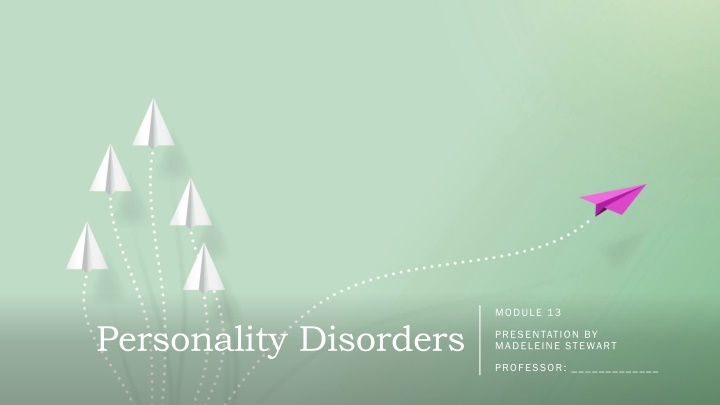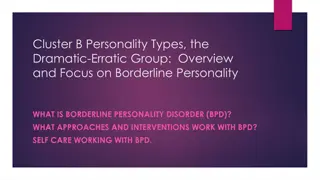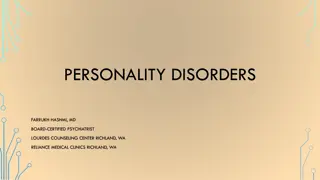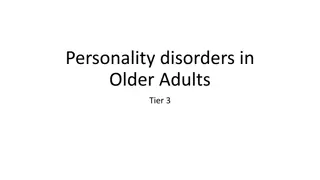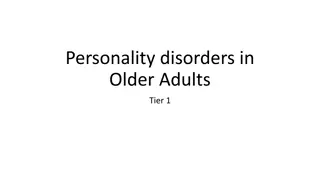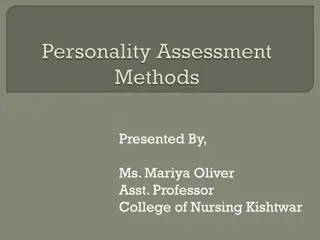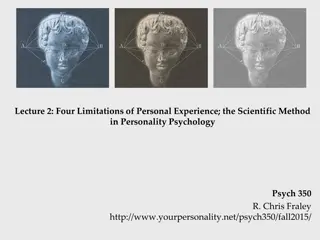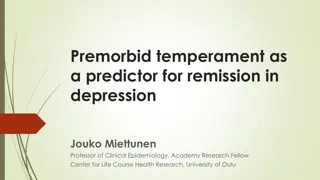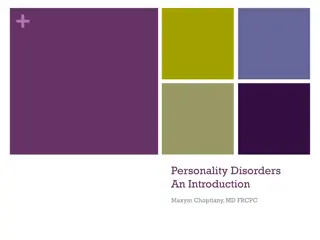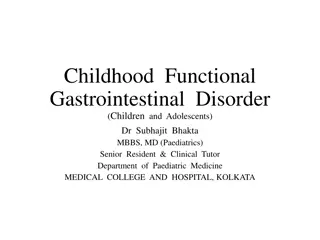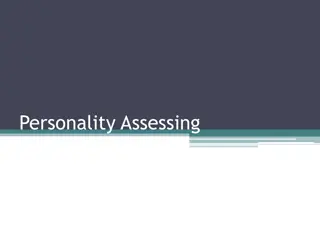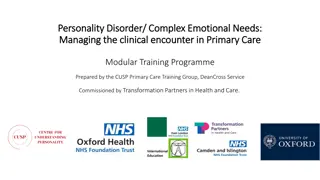Personality Disorders
Personality disorders are characterized by distorted thinking patterns, emotional responses, impulse control issues, and interpersonal difficulties. This presentation delves into the epidemiology, comorbidity, etiology, and treatment options for personality disorders, focusing on Cluster A, B, and C disorders. Learn about the prevalence rates, treatment challenges, and gender distribution of different personality disorders to gain a comprehensive understanding of these complex mental health conditions.
Download Presentation

Please find below an Image/Link to download the presentation.
The content on the website is provided AS IS for your information and personal use only. It may not be sold, licensed, or shared on other websites without obtaining consent from the author.If you encounter any issues during the download, it is possible that the publisher has removed the file from their server.
You are allowed to download the files provided on this website for personal or commercial use, subject to the condition that they are used lawfully. All files are the property of their respective owners.
The content on the website is provided AS IS for your information and personal use only. It may not be sold, licensed, or shared on other websites without obtaining consent from the author.
E N D
Presentation Transcript
MODULE 13 Personality Disorders PRESENTATION BY MADELEINE STEWART PROFESSOR: _____________
Describe how personality disorders present. Describe the epidemiology of personality disorders. Learning Objectives Describe comorbidity in relation to personality disorders. Describe the etiology of personality disorders. Describe treatment options for personality disorders.
Four defining features Distorted thinking patterns Problematic emotional responses Over- or under-regulated impulse control Interpersonal difficulties Must display these behaviors in adulthood. Children and adolescents (age <18) CANNOT CANNOT be diagnosed with a personality disorder. What are personality disorders?
Personality Disorder Clusters Cluster B Cluster A Odd/eccentric Cluster C Anxious/fearful Dramatic, emotional, erratic Paranoid PD Schizoid PD Schizotypal PD Antisocial PD Borderline PD Histrionic PD Narcissistic PD Avoidant PD Dependent PD Obsessive- Compulsive PD
Epidemiology of Cluster A Prevalence rate around 3-4% Paranoid PD 4.4% (no reported gender discrepancy) Schizoid PD 3.1% (more commonly diagnosed in males) Schizotypal PD 3.9% (more commonly diagnosed in males) PDs
Treatment for Cluster A PDs Patients don t often seek help, and those who do go to treatment, do not enter it willingly Patients struggle to trust the clinician because they re suspicious of the clinician s intentions or are emotional distant with a lack of desire to engage in treatment High drop-out rates CBT is used to reduce anxiety-related symptoms, address the misinterpretations of others words and actions, experience more positive emotions and engage in more satisfying social experiences, and/or evaluate unusual thoughts Sometimes includes social skills training
Prevalence Antisocial PD 3.3% (more commonly diagnosed in males, especially those with substance abuse disorders and those from disadvantaged socioeconomic settings) Borderline PD 5.9% (women make up 75% of the diagnoses) Histrionic PD 1.84% (diagnosis rate is equal between genders) Narcissistic PD 6.2% (men make of 75% of the diagnoses) Epidemiology of Cluster B PDs
Treatment for Cluster B PDs Antisocial PD options are limited and generally not effective; patients are often forced to participate in treatment where they try to address the lack of moral conscious and encourage patients to think about the needs of others Borderline PD treated with Dialectical Behavioral Therapy (DBT) which tries to reduce suicidal behavior, reduce therapy interfering behavior, improve quality of life, and reduce post-traumatic stress symptoms Histrionic PD more likely to seek treatment that other PD patients, but still difficult to treat because the individuals use their demands and seductiveness in the treatment setting; goal of treatment is to identify dependency and change helpless beliefs Narcissistic PD more difficult to treat because individuals only seek out help for secondary issues (e.g., depression); treatment addresses grandiose, self-centered thinking, and how to empathize with others
Epidemiology of Cluster C Aside from OCPD, these PDs are rarely diagnosed in the general public Avoidant PD 2.4% (equally found in men and women) Dependent PD - <1% (more frequently diagnosed in women) OCPD 7.9% (most diagnosed PD) While women are more likely to be diagnosed with OCD, men are twice as likely as women to be diagnosed with OCPD PDs
Difficult to keep patients in treatment due to distrust or fear of rejection from the clinician For avoidant PD, treatment is like that of social anxiety disorder (e.g., CBT); likewise, clinicians may use gradual exposure and social skills training Treatment for Cluster C PDs For OCPD, there are cognitive techniques aimed at changing dichotomous thinking, perfectionism, and chronic worrying Comorbid anxiety disorders may be alleviated with antianxiety or antidepressant medications, but symptoms often resume when medication is discontinued For dependent PD, clinicians try to teach them to accept responsibility for themselves, both in and outside of treatment; couples or family therapy may help, too
Cluster A Personality Disorders
Paranoid Personality Disorder Often feel as though they have been deeply and irreversibly hurt by others even though there lacks evidence to support this Hesitant to share with or confide in others for fear the information will be used against them Marked distrust or suspicion of others, and therefore doubt relationships Quick to hold grudges and unwilling to forgive insults or injuries whether intentional or not Benign remarks or events are often interpreted as demeaning or threatening Quick to angrily counterattack either verbally or physically when they feel insulted
Schizoid Personality Disorder Display a persistent pattern of avoidance from social relationships along with a limited range of emotion among social relationships Do not have many close relationships because they lack the desire to engage with others Lack of desire for establishing social relationships also extends to sexual behaviors Described as having a bland exterior in that they rarely reciprocate facial expressions or gestures (e.g., smiles, nods) Often indifferent to criticisms or praises of others and appear to not be affected by what others think of them Limited need for attention or acceptance
Schizotypal Personality Disorder Ideas of references the belief that unrelated events pertain to them in an unusual way; can lead to superstitious behaviors or preoccupation with paranormal activities (e.g., they may believe they have special powers) Characterized by a range of impairment in social and interpersonal relationships due to discomfort in relationships, along with odd cognitive and/or perceptual distortions and eccentric behaviors Individuals seek isolation and have few established relationships Can have auditory hallucinations, as well as unusual speech patterns of derailment or incoherence Component of paranoia or suspiciousness of others motives Display inappropriate or restricted affect; significant social anxiety
Cluster B Personality Disorders
Common behaviors include aggression toward people or animals, destruction of property, deceitfulness or theft, or serious violation of rules Persistent pattern of disregard for, and violation of, the rights of others with a lack of remorse for the consequences of their actions Begins in late childhood or early adolescence and continues through adulthood; before age 18, this is called Conduct Disorder Pattern of impulsivity without forethought of consequences (this can cause it to be difficult to hold a job, and thus many with this disorder find themselves in debt) Extreme irritability or aggression with a disregard for their own safety or the safety of others Commonly called psychopaths or sociopaths Antisocial Personality Disorder
Will often go to great lengths to avoid real or imagined abandonment; in fact, their fear of abandonment can lead to inappropriate anger Display a pervasive pattern of instability in interpersonal relationships, self-image, and affect May experience intense mood fluctuations and volatile interactions with others Sometimes features hallucinations or delusions (usually of a paranoid nature), but these are transient symptoms and recognized as unacceptable by the individual Often engage in impulsive behaviors such as self-harm, sexual promiscuity, and suicidal behaviors to prevent abandonment Unstable and/or intense relationships Borderline Personality Disorder
Often very lively and dramatic which can be initially charming, but will eventually wear down the audience Individuals are often uncomfortable in social settings unless they are the center of attention May make-up stories and/or cause dramatic scenes May engage in sexually seductive or provocative ways and/or spend significant time on their physical appearance Over-exaggerate relationships Easily suggestable Histrionic Personality Disorder
Over-evaluate their abilities and accomplishments and come across as boastful and pretentious Need excessive admiration from others; and their self-esteem is extremely inflated but fragile Individuals display a pattern of grandiosity along with a lack of empathy for others Envious of others who achieve greater success or possessions and believe that everyone should be envious of them Often have difficulty (or choose not to) recognizing the desires or needs of others Exploit interpersonal relationships Narcissistic Personality Disorder
Cluster C Personality Disorders
Display a pervasive pattern of social anxiety due to feelings of inadequacy and increased sensitivity to negative evaluations Driven by their fear of being rejected Avoidant Personality Disorder Reluctant to engage in social situations, and thus it is difficult to maintain employment Have very few if any friends, despite their desire to establish social relationships Often exaggerate the potential negative consequences and embarrassment that may occur if they take up new activities or relationships Do not typically suffer from social skills deficits, but rather from misattributions of their own behaviors
Characterized by pervasive and excessive need to be taken care of by others Leads to submissive and clinging behaviors as they fear they will be abandoned or separated from the person with whom they are in a dependent relationship Dependent Personality Disorder Can t even make the smallest of decisions without consulting the other person and will rarely challenge decisions made by others Significant feelings of helplessness and quickly seek out another relationship if their old one ends Express difficulty initiating and engaging in tasks on their own due to a lack of self-confidence Will go to great lengths to seek out support of others
Defined by an individuals preoccupation with orderliness, perfectionism, and ability to control situations that they lose flexibility, openness, and efficiency in everyday life Impaired by their own high standards and need to complete the task perfectly, so much so that the task often does not get completed Obsessive- Compulsive Personality Disorder Will not seek help from others, as they are convinced that the others are incompetent and will not complete the task up to their standard Often rigid and stubborn, particularly with their morals, ethics, and values; and they expect others to have similarly high standards May prepare financially for a potentially catastrophe May have difficulty discarding worn-out or worthless items, despite their lack of sentimental value
Often comorbid with: Mood disorders (major depressive disorder, bipolar disorder, and dysthymia) Anxiety disorders Substance abuse disorders More specifically: Cluster A: Least likely to be found with major depressive disorder Schizotypal is highly comorbid with anxiety disorders Cluster B: Highly comorbid with bipolar disorder Borderline is highly comorbid with anxiety disorders Narcissistic is likely to be diagnosed with GAD and panic disorder Cluster C: Highest rate of comorbidity with major depressive disorder OCPD is highly comorbid with bipolar disorder Comorbidity
Biological Causes Schizotypal PD Schizotypal PD Antisocial and Borderline PDs Antisocial and Borderline PDs May have similar biological causes to that of schizophrenia (high activity of dopamine and enlarged brain ventricles) Deficits in serotonin activity Deficient functioning of the frontal lobes (particularly the prefrontal cortex) and an overly reactive amygdala
Psychological Causes Psychodynamic places a large emphasis on negative early childhood experiences and how these experiences impact an individual s ability to establish healthy relationships in adulthood Cognitive Dichotomous thinking all or nothing thinking Discounting the positive the inability to accept positive feedback from others, expecting to only receive rejection and harsh criticism Behavioral Modeling PDs explained by an individual learning maladaptive social relationship patterns and behaviors due to directly observing family engaging in similar behaviors Reinforcement parents may unintentionally reward aggressive behaviors by giving in to a child s desires to cease or prevent escalation; praise and/or reinforcement may also contribute to a grandiose sense of self Lack of social skills the avoidance of social situations contributes to the development of PDs
Social Causes Family Dysfunction Includes poverty, unemployment, family separation, and witness domestic violence Childhood Maltreatment One s sense of self and the ability to relate to others (which are both impaired by PDs) are formed in the first four to six years of life and is affected by the emotional environment in which someone is raised 4 types of attachments or emotional bonds (investigated by John Bowlby) Secure the only attachment type that generally does not develop PDs Anxious at risk for internalizing disorders Ambivalent at risk for externalizing disorders Disorganized at risk for dissociative symptoms and personality related disorders
